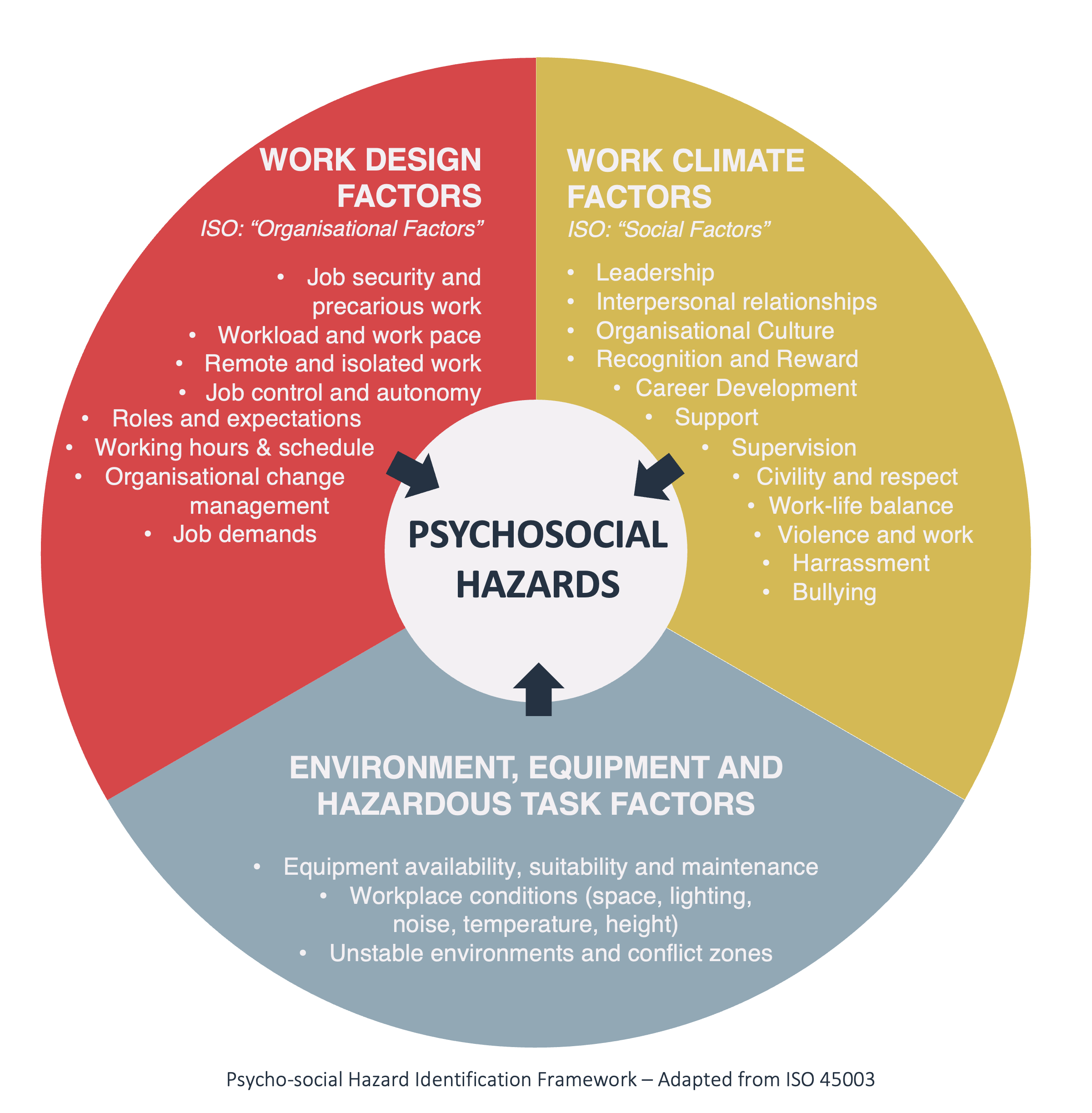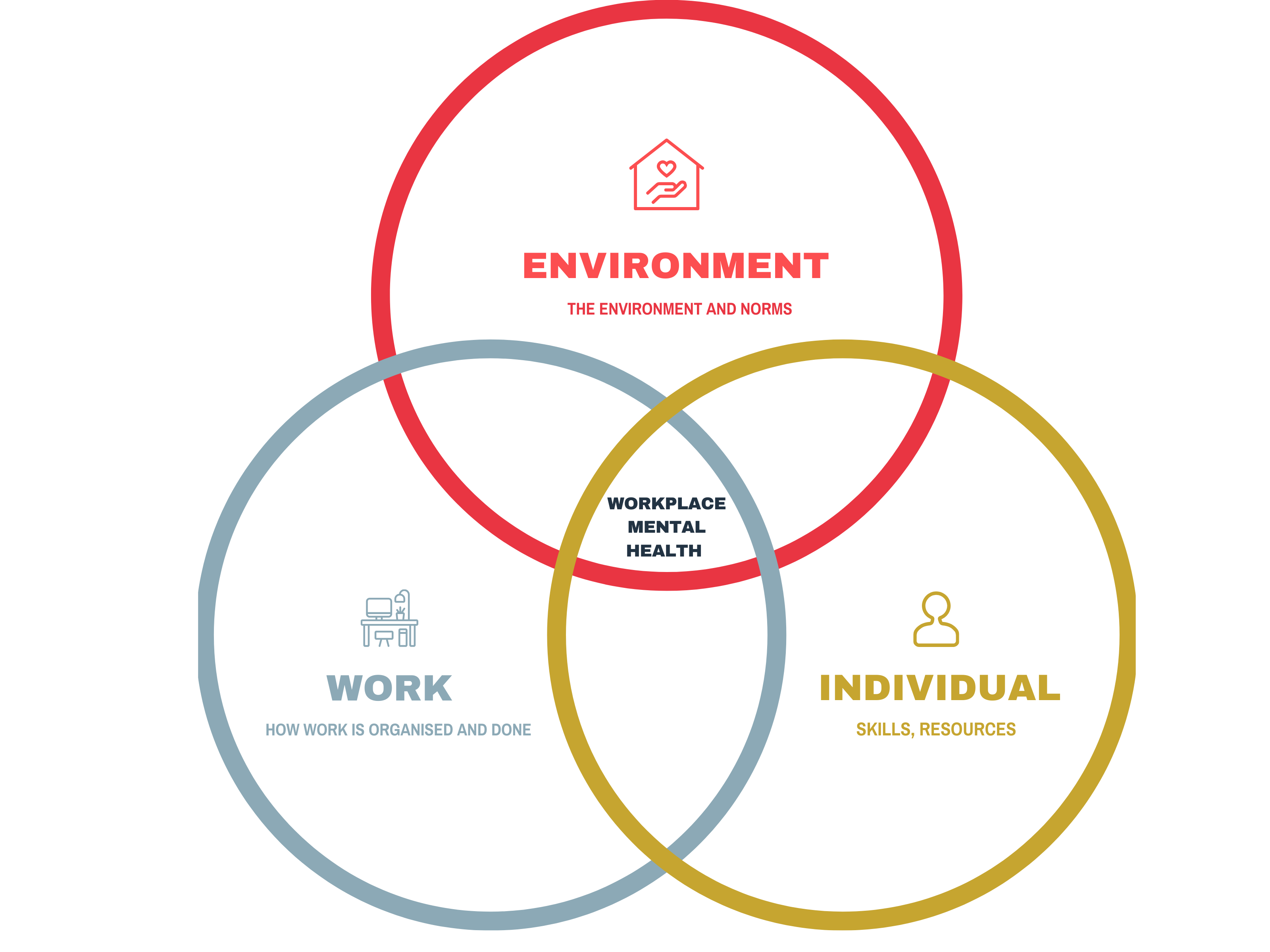
WHAT IS PSYCHO-SOCIAL RISK AND WHY DOES IT MATTER?
Australian employers have obligations to identify and manage psycho-social hazards within the workplace. To better understand these obligations and how well an organisation is meeting them, we first need to understand what psycho-social hazards are, why they are essential, and how they can be managed.
What are Psycho-social Hazards?
What are Psycho-social Hazards and Psycho-social Risks, and how do they differ from broader mental health concepts?
Psycho-social Hazards can be defined as: ‘those aspects of work design and the organisation and management of work, and their social and environmental contexts, which have the potential for causing psycho-social or physical harm.’ Psycho-social hazards can occur in combination with one another and influence or be influenced by other hazards.
Psycho-social Risks refer to the potential a psycho-social hazard has to cause harm, including negatively impacting an individual’s mental health and causing physical harm such as increased blood pressure.
Mental Health is defined by the WHO Health Organization as ‘a state of well-being in which the individual realizes his or her own abilities, can cope with the normal stresses of life, can work productively and fruitfully, and is able to make a contribution to his or her community’.
Workplaces can influence the mental health of workers by managing psycho-social risks.
Why do Psycho-social Hazards Matter?
From a human perspective, leaders want to provide a workplace in which employees feel safe, both physically and psychologically.
From an economic perspective psycho-social hazards contribute to:
- Lower productivity, increased absenteeism, work-related psychological injuries and illnesses, and issues with retention and recruitment
- Regulatory investigations and compensation claims.
Attention and investment in improving the mental health of the workforce has steadily increased over the last decade; however, despite this focus by employers, the rate of psychological injury within workplaces has significantly increased. Psychological injuries are more costly and time-consuming than physical injuries. On average, employees with a mental health conditions are away from work for 14.8 weeks compared to 5.3 weeks for a physical injury. The average cost of a psychological injury is $23, 600 versus $8, 700 for a physical injury. 54% of all psychological injury claims are rejected compared to only 4.9% for physical injury claims.
The most common Mental Disorder claims (90%) are attributed to mental stress. The most common mechanism for mental stress is work pressure (32%) and Bullying and Harassment (24%), with 65% of mental disorder claims awarded to workers over the age of 40.
Understanding these mechanisms for psychological injury is necessary to focus organisations efforts on ensuring psycho-social hazards that contribute to these injuries are well managed.
How can Psycho-social Hazards be Managed in the Workplace?
A number of Codes of practice and the recent release of the Occupational health and safety management – Psychological health and safety at work – Guidelines for managing psycho-social risks (ISO-45003), have been developed to assist organisations to manage these hazards as they would physical hazards, utilising a risk-based approach.
Improving workplace mental health is influenced by controlling and managing psycho-social hazards across three key areas as outlined below:
- Work Design (Organisational Factors) – how work is organised, job design, systems, policies and processes
- Work Climate (Social Factors) – how people operate within the work systems, culture and interpersonal relationships within the workplace
- Physical work environment – equipment and exposure to hazardous tasks such as physical violence, noise, conflict

Humanology Group’s Psycho-social Risk Management Framework
Humanology Group utilise a risk management framework that is effective in controlling physical hazards. The Critical Control Risk Management process is the internationally recognised approach for high-risk organisations. It focuses on the effective management of critical controls to prevent and mitigate rare but potentially major unwanted events. We utilise this methodology to allow a thorough, systematic process that assists client companies focus on what matters ensuring the hazards identified are controlled effectively. The successful implementation of this framework creates an ongoing cycle of improvement vs a static state assessment. Embedding control assurance strategies and control effectiveness reporting is a key step, often missed by many organisation’s implementing a psycho-social risk management framework.
Managing Psycho-social Hazards in the Workplace
A risk-based approach guides the identification of factors such as severity, frequency and duration that influence the impact of Psycho-social hazards. Take workload as an example of a psycho-social hazard. The risk of developing a psychological injury from a high workload depends on the severity, frequency and duration of exposure. Suppose a worker is put under an increased workload to meet a tight deadline for a project. In that case, it may be manageable given it is for a short period, requires 2-3 days of working 16 plus hours, and is further mitigated by factors such as having a supportive team and leader.
On the other hand, the workload may translate into a risk if a worker is constantly exposed to a high workload, having to complete 16-hour days to stay on top of routine tasks, has been working under these conditions for the duration of their employment, further compounded by a leader who emails requests or directions at 1 am and considers the workload as acceptable.

To simplify psycho-social hazard management further we can examine a more recognisable physical injury such as hearing loss, to understand the risk, we need to understand the hazard, noise; how loud the noise is, how often the worker is exposed to it and the length of time exposed. When we can identify these aspects, we can truly understand the risk the hazard poses and potential controls to eliminate or reduce the hazard.
Traditional interventions to reduce psychological injury and improve employee mental health have typically focused on tertiary, individual interventions such as Employee Assistance Programs (EAPs), healthy lifestyle programs, mental health first aid etc. The limited effectiveness of these programs is due to their focus on individual-level tertiary interventions that do not control for the psycho-social hazard that is creating harm and treat the symptoms rather than the cause of the problem. Take workload as outlined above; referring a worker to the EAP when they report stress symptoms will not address the cause of the high workload and will likely result in the employee continuing to be exposed to these workplace psycho-social hazards.
Identifying, monitoring and controlling these hazards ensure organisations take a primary and secondary preventative organisational approach to improve workplace mental health.
